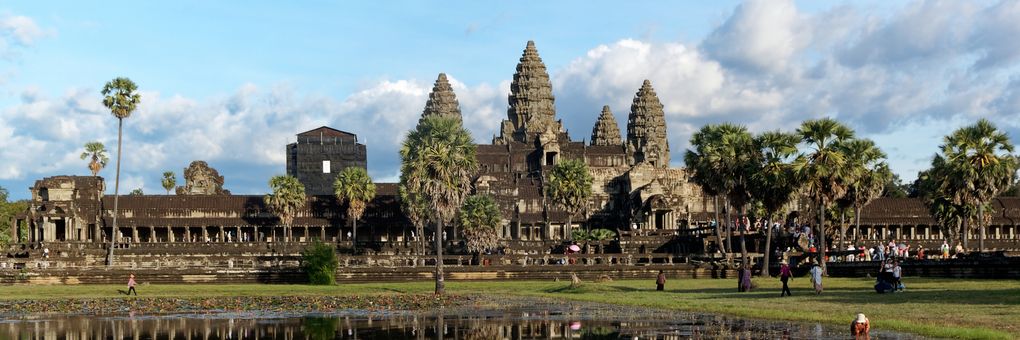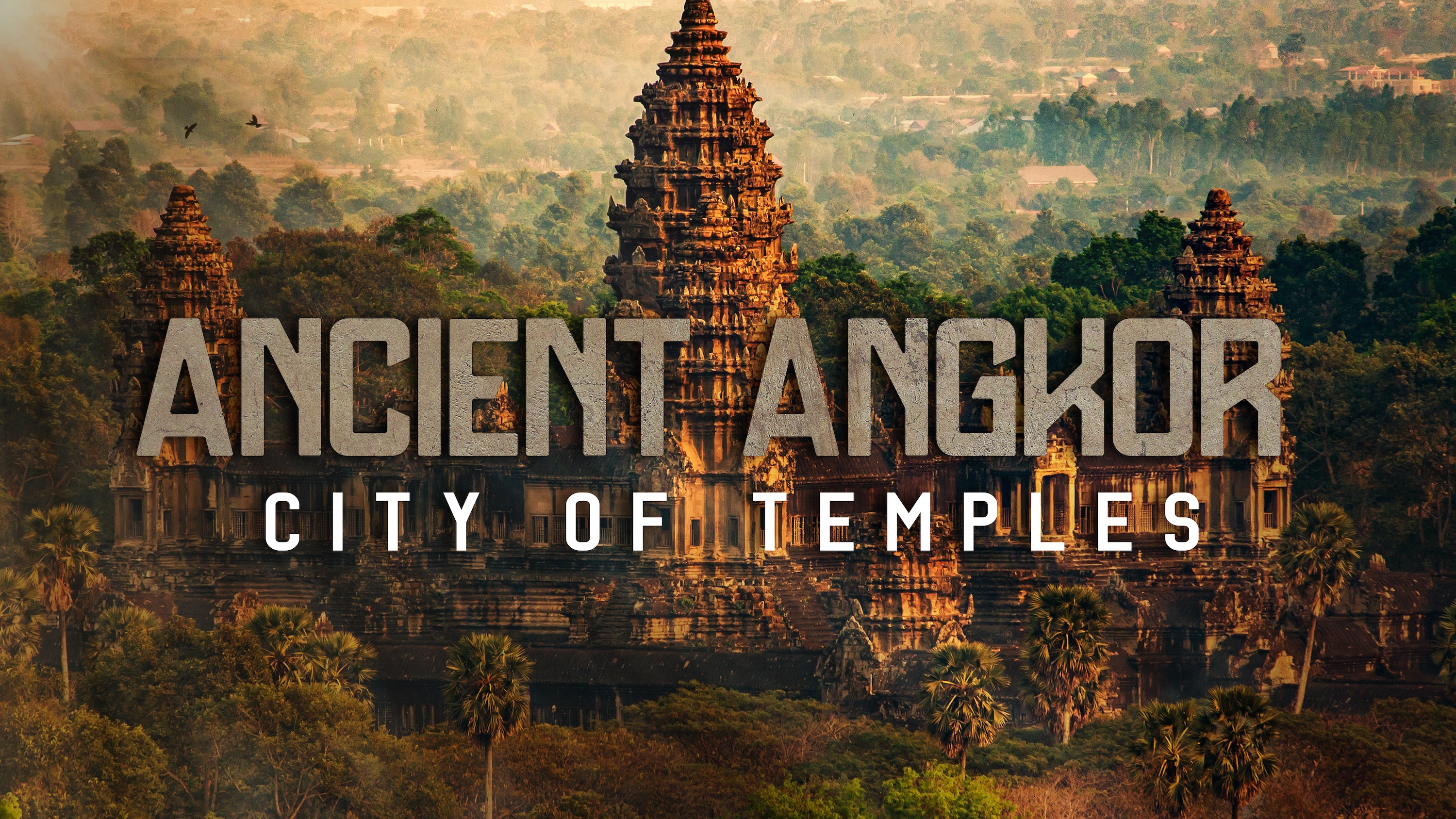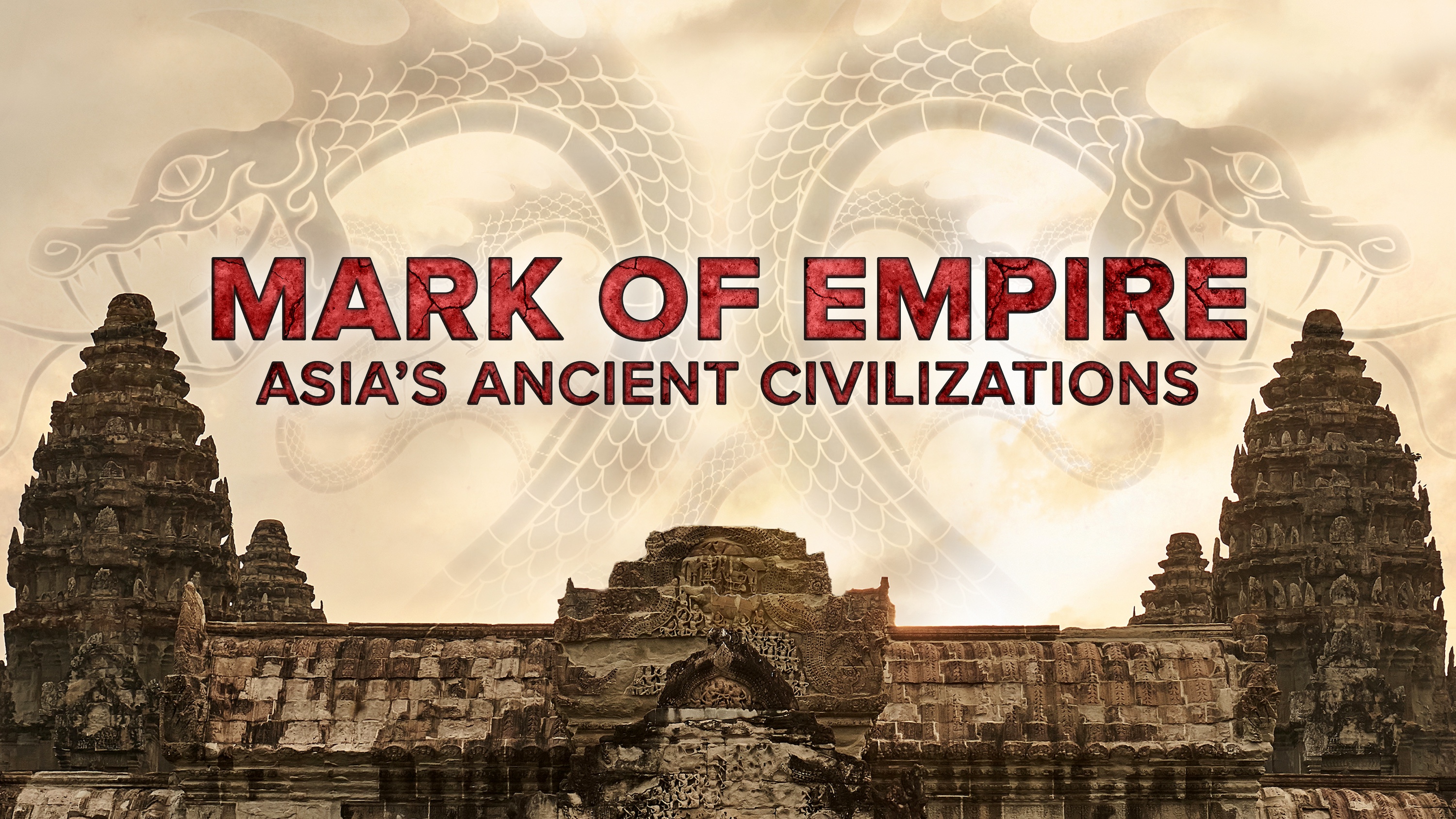Angkor Wat and Ta Prohm are two of the greatest relics of Cambodia’s Khmer Empire. They, and all the Angkor Temples, are key to understanding the country’s past, present, and future.
◊
My tuk-tuk driver dropped me off in a busy parking lot by a forest. The midday heat was already rising as I made my way up a wooden staircase and entered the trees.
The jungle rose around me. Faint music hummed from somewhere, and clouds threatened to burst as I moved closer. For a moment I could imagine I was no longer in the present day, but instead had been transported back to a time when the temples of Cambodia’s Angkor Archaeological Park echoed with the footsteps of monks and kings.
The music grew louder, and soon it became clear that the sound was coming from a group of performers seated under a small thatched roof. A sign read that they had lost their legs to landmines during and after Cambodia’s brutal Khmer Rouge regime, which was in power from 1975 to 1979 and led to the deaths of up to three million Cambodians. Now, the performers held their instruments and played music for the many passersby wandering through to experience one of the world’s great wonders.
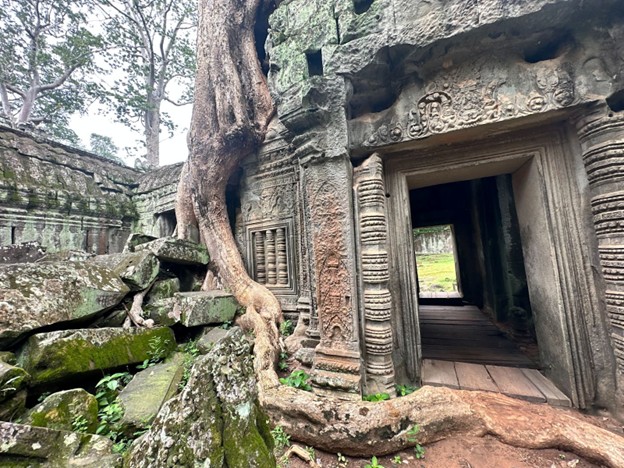
An overgrown doorway at Ta Prohm (Photo by Eden Arielle Gordon)
I arrived at the temple, called Ta Prohm, to find a moss-covered, half-ruined structure that seemed to have been conjured from a dream. The damp air made the green moss on the walls shine with the brilliance of emeralds. Headless Buddha statues rested inside labyrinthine hallways. Gigantic trees grew out and through every part of the building, their roots melting over the caved-in roofs. Together, the natural and the manmade danced in a blur of destruction and rebirth that seems to define both Cambodia’s history and often, I find, existence at large.
Ta Prohm is one of the most famous temples in the Angkor complex, which was created by the Khmer Empire during their reign from 802 to 1431 CE. Today, the temples linger quietly in the forests, but once they were glittering jewels of Khmer civilization, centers of power and worship that still emanate a sense of undeniable grandeur.
Yet despite its staggering beauty and significance, the temple remained strangely silent to me, like an impenetrable fortress of mysteries. I knew Ta Prohm was the temple made famous in Angelina Jolie’s Tomb Raider franchise, and I knew it had been a Buddhist place of worship, yet I still found myself wanting to know more about this place – about the individual carvings and nooks and crannies that seemed like portals to other worlds.
I could feel stories echoing from the very soil. So the next day I enlisted a guide, and we began our day at the most famous of the temples: Angkor Wat.
Explore the vast wonders of the Angkor Temples in this exquisite MagellanTV documentary.
The Crown Jewel of the Khmer Empire: Journey to Angkor Wat
A faint sunrise pushed through milky clouds as we arrived at the temple just shy of five in the morning. Under a full moon that remained visible in the sky despite the gathering daylight, my guide, a former monk, explained that the structure was meant to resemble the Hindu cosmological universe. Walking through it, he said, is meant to guide the visitor toward enlightenment.
Angkor Wat was erected during the heyday of the Khmer Empire. The first of the empire’s great stone temples, Preah Ko and Bakong, were commissioned by a ruler named Indravarman I in the late 800s, but construction kicked into high gear with the ascension of the great Suryavarman II, who unified the Khmer Empire after a period of unrest and set about building what would become Angkor Wat.
As we walked, my guide told me that he used to come to the temple often as a child, before the Khmer Rouge began destroying Cambodia; his eyes clouded over as he shared memories of bombs falling while he hid in shelters. After the regime was deposed, he said, he started coming to the temple again and would spend long hours wandering its grounds, trying to make sense of what had happened. Buddhism and meditation had saved him in the aftermath, he explained, and so had music. We bonded over both subjects as he guided me through various rooms and explained how the temple had been built.
 Angkor Wat at dawn (Credit: Vincent Gerbouin, via Pexels)
Angkor Wat at dawn (Credit: Vincent Gerbouin, via Pexels)
How Angkor Wat Was Built
Constructed between 1122 and 1150 CE, Angkor Wat was dedicated to the Hindu god Vishnu. The five stone towers represent the five peaks of Mount Meru, the mythical home of the gods of Hinduism and Buddhism, and the moats and passageways around them symbolize the oceans and mountains that surround this sacred peak.
Many scholars believe that the temple was also intended to be a mausoleum for Suryavarman II. It is clear that temples of the Khmer Empire were not only tributes to the gods – they were also meant to affirm the godlike natures of the empire’s rulers, who saw themselves as representations of these gods on the earthly plane.
My guide and I passed by the infamous bas relief called the Churning of the Ocean of Milk, which depicts a story from Hindu mythology about how, at the very beginning of time, gods and demons were forced to work together to wrest an elixir of life from the primordial ocean. Other carvings depicted more mundane scenes, such as the Khmer Empire’s many battles for territory.
Along the way, I couldn’t help but stare in awe at the size and scale of the whole thing. The construction of Angkor Wat, and all the temples of Angkor, was a miraculous feat in and of itself. Angkor Wat alone likely required over 300,000 people and 6,000 elephants to build, according to some inscriptions.
Most of the massive sandstone bricks used to build the temples of Angkor came from the nearby Kulen Mountain, and new research suggests that they were likely transported along to the site across a series of canals and roads that stretched 22 miles from Tonle Sap Lake to the site. Every stone was laid intentionally, it seems, for Angkor Wat was designed so that the Sun hovers directly above the structure’s highest peak on each equinox – a remarkable marriage of nature and human ingenuity that is still visible twice a year, like clockwork, today.
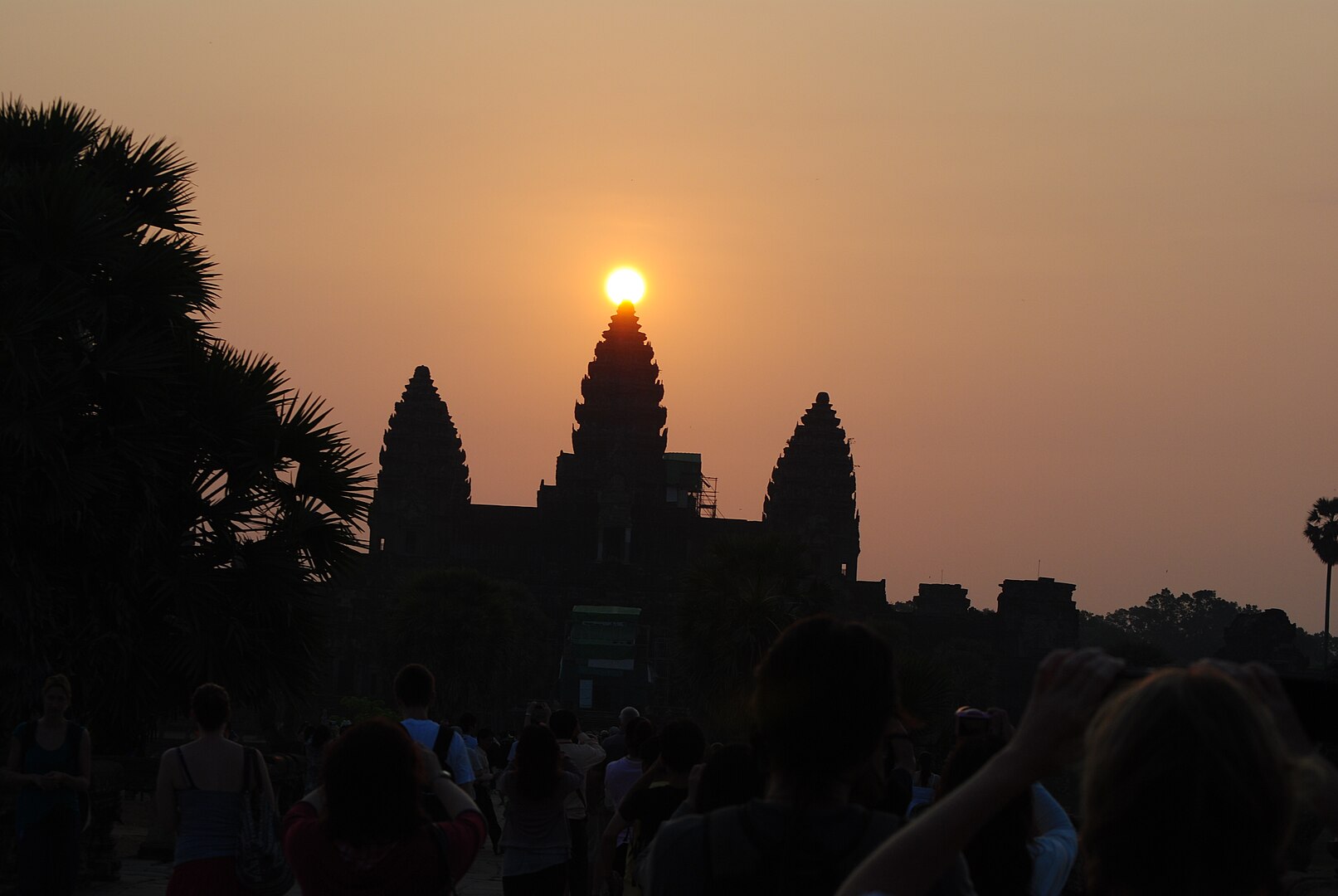 Angkor Wat at the equinox (Source: Wikimedia Commons)
Angkor Wat at the equinox (Source: Wikimedia Commons)
Angkor Wat remained active throughout the Khmer Empire and began serving as a Buddhist monastery in the 13th century before falling into disrepair. Eventually, like most of the other Angkor temples, it was restored with assistance from foreign governments during the 20th century.
Today, its power can truly only be felt, not described. Every single spire and wall we walked past was covered from top to bottom with detailed carvings of various figures from Hindu mythology and Khmer military history. Libraries and towers loomed through every window. A golden Buddha shimmered from inside one room – evidence of the Khmer Empire’s eventual pivot to Buddhism – and monkeys swung among the incense smoke that emanated from the door. We laid some incense down, whispered our prayers, and then pushed through crowds to the exit.
Swallowed by Trees: Jayavarman VII, Ta Prohm, and the Rise of Buddhism in Cambodia
From Angkor Wat, we headed into the woods for a deeper dive back into the green labyrinth of Ta Prohm. morks of roads and public works, and founded and sponsored over a hundred hospitals. He also helped transition the official Khmer religion from Hinduism to Buddhism, and built numerous Buddhist temples, including Bayon Temple, which served as his mausoleum, and Ta Prohm, which was a tribute to his mother.
As we wandered through Ta Prohm, I gazed at the tree-draped stone walls, which depicted glimpses of day-to-day Khmer life, long-armed Buddhist deities, and countless bejeweled apsaras, which are celestial dancers in Hinduism and Buddhism.
 A carving of an apsara at Angkor Wat (Credit: Diego Delso, via Wikimedia Commons)
A carving of an apsara at Angkor Wat (Credit: Diego Delso, via Wikimedia Commons)
After Jayavarman VII’s reign, the Khmer Empire would last another two centuries before it finally collapsed after the Thai kingdom of Ayutthaya took the capital city, though drought and other factors had led to its decline.
Like all things, the Khmer Empire came to an end, but its vast temples remained standing. Now I found myself deep within one, in a place that nature and architecture and time itself had all collaborated on. Butterflies floated over the weeds. Monkeys screeched somewhere far away, and I imagined I could hear the footsteps of the monks who once walked these halls, giving their lives away in pursuit of compassion and presence.
Jayavarman VII, it seemed, had also lived his life in pursuit of these things, striving to create an earthly paradise in his kingdom. If only it had lasted, I thought.
Still, despite the common myth of the Angkor temples as a “lost” city that was “rediscovered” by the French, they never fell entirely out of use. Khmer people always used them as shrines and pilgrimage sites, even as the jungle slowly enveloped the site. And I, as a visitor, would never fully understand what these places had meant.
Join historian Peter Lee as he explores four massive Southeast Asian empires in this fascinating MagellanTV series.
Today, Angkor Wat and its surrounding temples do suffer from overtourism that has even led to water shortages, and I did frequently find myself wondering what the majestic structures would have been like without the swaths of people. But in the rare moments of quiet, when the hum died down and it was just me and the mossy stones, I imagined I could feel just a bit of it.
Songs in the Dark: Angkor Wat and Cambodia Today
After we visited our final temple of the day, my guide and I found ourselves stuck in traffic, trapped inside a massive car show that apparently was being attended by the head of the Cambodian People’s Party himself. I would later learn that the country’s political leader, whose name is Hun Sen, had been a Khmer Rouge commander, and most of the profits from Angkor Wat – by far the country’s top moneymaker – still go to the government.
Still, as I watched the cars, my guide and I spoke about none of that; he simply thanked me profusely for visiting Cambodia. The country is clearly on an upswing. I was impressed by the huge number of food and lodging options in beautiful Siem Reap, and with the rich hospitality and overall safety I felt among the nation’s people.
I would spend six more weeks in Cambodia, extending my stay repeatedly, learning more and more about the temples along the way. I spoke to spiritual guides draped in white linen who called the temples energetic vortexes aligned with Stonehenge and the Egyptian pyramids. I wandered lesser-known temples at night and drove through them on motorbikes. I don’t believe I found enlightenment, but I did fall in love with both Cambodia and these temples. They are awe-inspiring testimonies to the powers of human faith and ingenuity as well as symbols of nature’s ultimate power over all our creations.
The night after my guided tour of Angkor Wat, before I knew any of that would happen, I agreed to meet my guide at a local hostel to play some music. We both brought our guitars, and he pulled out a songbook that featured some of my favorite tunes in English, Thai, and Khmer.
As we sang “Fire and Rain,” I thought about how great stories – whether they’re stories of enlightenments experienced under Bodhi trees, or songs played out by the wounded, or James Taylor songs by sparkling blue swimming pools sung together by two people from different worlds – ultimately have the power to work wonders, and can far transcend the limits of a single lifetime or empire. Angkor Wat, like all great temples, is a tribute to some of the most ancient and powerful stories of all. I’m glad I could make it a part of mine.
Ω
Eden Arielle Gordon is a journalist based in New York. Her work has been published in Slate, Atlas Obscura, Success Magazine, and Self, and she was formerly an assistant editor at Vox Media’s Popsugar. An avid world traveler, she is also a singer-songwriter and poet, and her debut poetry collection, Prisms, was published in 2024.
Title Image: Angkor Wat (Credit: Jakub Halun, via Wikimedia Commons)

